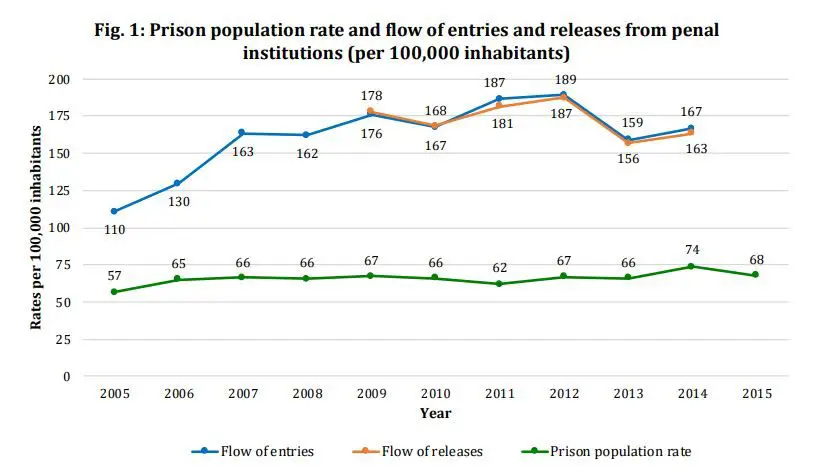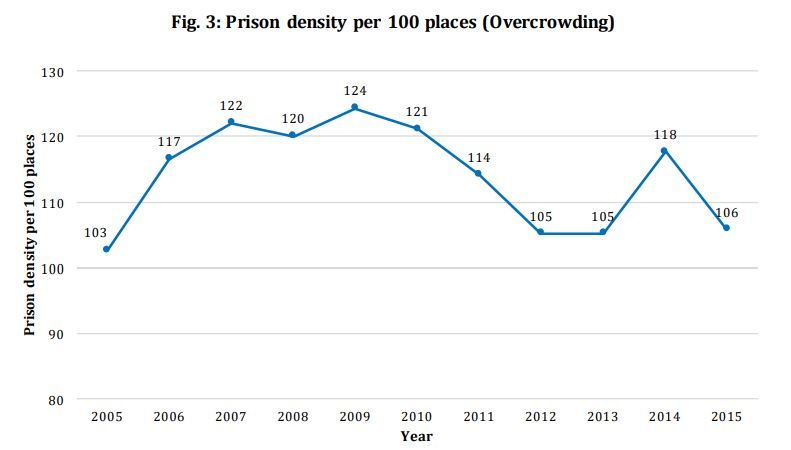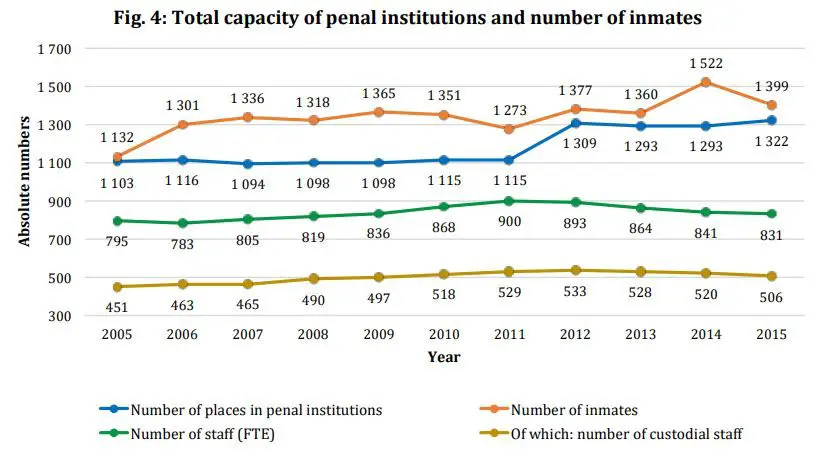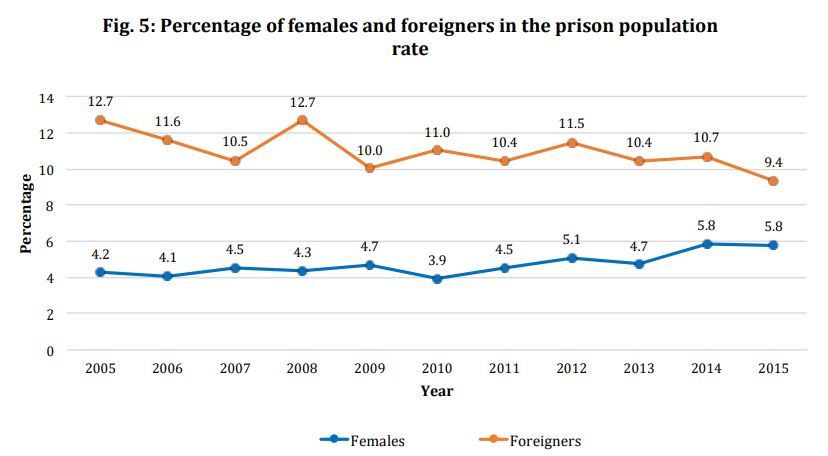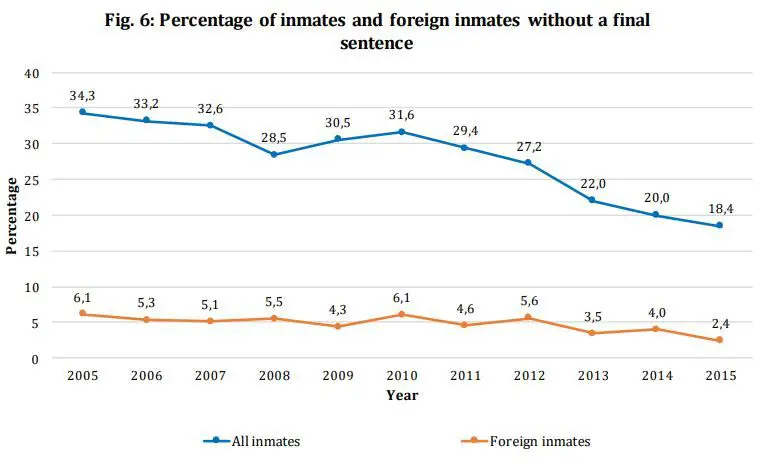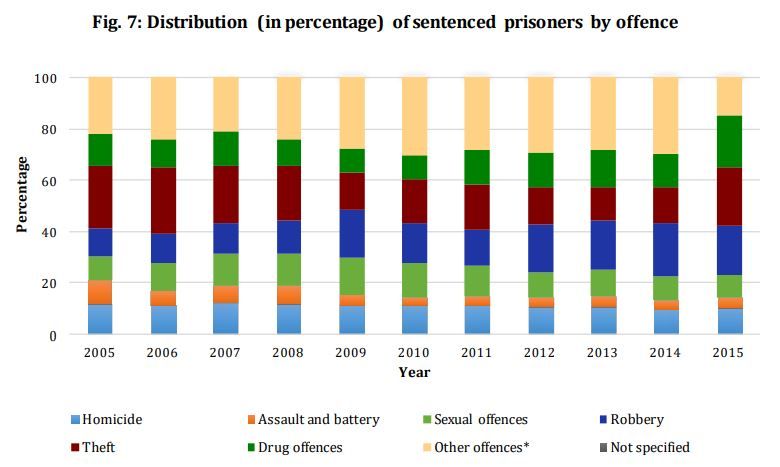Ljubljana related
Last week the Minister of Justice Lilijana Kozlovič visited Ig female prison where she was also presented with the annual report from the National Prison Administration (Uprava za izvrševanje kazenskih sankcij) for the year 2019.
Ig prison is located in a 500 years old castle building for which a renovation and extension is planned. The works are supposed to commence in 2021, and the investment itself is expected to amount to more than 34 million euros. Apart from Ig, another prison is planned to be constructed in Dobrunje, where male prisoners from Povšetova in Ljubljana would be moved.
Last year, an average of 1,435 people were imprisoned in the Slovenian prison system, which is 6% more than the year before. This significant increase is largely due to those detained for those caught helping people to illegally crossing the state border. A significant increase in foreigners among inmates has been noticed as well, with non-Slovenes composing 30% of the entire imprisoned population.
The problem of overcrowding was partially solved by moving people between different institutions; however, prisons in Ljubljana, Koper, Novo mesto and Nova Gorica were still working over the limit of their capacity.
In her press statement Lilijana Kozlovič said that there was a possibility of introducing an alternative to prison sentences. She announced that a material basis would be created for a different kind of sentencing, namely penalties of non-confinement, where she sees great benefits in some already existing re-socialisation and community service programmes.
STA, 18 November 2019 - The Ljubljana city council has unanimously endorsed the construction of a long-awaited prison in the area of the Slovenian capital, which will enable the government to expand the country's crowded prison facilities.
The city council backed on Monday a decree on the municipal zoning plan which enables the government to build a men's prison in Dobrunje, along the eastern part of Ljubljana's ring road.
Slovenia’s Prisons are Overcrowded, But Custodial Sentences Short
The new facility will have room for 388 inmates and is to replace the prison in Povšetova Street in Ljubljana, the occupancy rate of which ranges from 110 to 120%.
The investment into the new facility, which could be built in a public-private partnership, is estimated at around EUR 68 million.
Justice Minister Andreja Katič said in a recent interview that the ministry hoped the prison's construction would begin in 2021.
The plans for a new prison have been long in the making as prison facilities for men have been overcrowded in recent years.
Slovenia’s Incarceration Rate Low, Jails Slightly Overcrowded, More Foreign Prisoners Last Year
A report by the Council of Europe released in April showed Slovenia's prisons were "slightly overcrowded" in 2018, as there were an average 100.5 inmates per 100 places available.
At the time, the Prison Administration said it had been trying to solve the problem by means of organisational measures, but noted a new prison would be the only long-term solution. It also said the occupancy rate this spring was 104%.
STA, 25 July - Slovenia has been seeing a spike in illegal migration in recent months, but while most of the migrants are being returned to Croatia, the smugglers who helped them across the border are filling up Slovenian prisons.
A report by the news web site of the public broadcaster rtvslo.si cites official data showing that foreigners account for nearly a quarter of Slovenia's prison population. Half of them have been incarcerated for smuggling migrants.
There are currently 323 foreign citizens in Slovenian correction facilities, 177 of them in custody, Prison Administration data show. "Out of 323 foreign citizens, 176 are in prison or in custody on suspicion of organising illegal crossings across the border."
Smuggling of migrants carries up to five years in prison and a fine, while those who make money by facilitating illegal entry of migrants into the country face sentences of up to eight in years in prison.
Slovenian police apprehended more than 200 illegal migrants only last weekend, 122 of them at several small camps in the woods where someone appeared to have left bags with food and basic necessities for them.
Interior Minister Boštjan Poklukar commented that this was a case of organised smuggling of migrants, committed both by individuals and smuggling rings.
There are no official statistics on the number of smugglers apprehended, but the General Police Administration told rtvslo.si that they had apprehended 153 smugglers of migrants last year, and as many as 132 by the end of July this year already.
The apprehended smugglers are as a rule remanded in custody, worsening the cramped conditions at Slovenian prison facilities. The capacities are most overcrowded at the prisons in Koper and Novo Mesto, at 128% and 126% capacity utilisation rates.
Foreign prisoners come from 46 countries, while there is also one whose nationality is unknown.
Interior Ministry data show that 1,802 migrants applied for international protection in Slovenia in the first half of the year, which compares to 2,875 the whole last year. Forty have been granted asylum this year and 102 last year.
A total of 680 people who have been granted international protection are living in the country at the moment. Between 1995 and the end of 2018, the status was granted to 818 third country citizens.
All our stories on human trafficking are here, those on illegal migration are here, and those on prison are here
STA, 2 April 2019 - Slovenian prisons are slightly overcrowded, shows a report on the state of European prison systems released by the Council of Europe (CoE) on Tuesday. The country's incarceration rate remains one of the lowest in Europe, with an increase of foreign prisoners recorded last year.
The number of inmates in Slovenia slightly exceeded the number of places available in 2018. Slovenia had an average 100.5 inmates per 100 places available, while the European average was 91.4.
Responding to the report, the Slovenian Prison Administration said it was trying to solve the problem by means of organisational measures, however the only long-term solution would be building a new prison.
Slovenia has been grappling with the problem for years. It culminated in 2014 when the prison population peaked. It was declining in the coming years, but the prison population trend turned up again in 2018.
The administration said the current occupancy rate was 104%. Due to an increase in remand prisoners, some facilities are overcrowded. There were an average 319 remand prisoners in 2018, an eight-year high.
The CoE report highlights eight countries dealing with severe prison overcrowding, including North Macedonia (122.3 inmates/100 capacity), Romania (120.5/100) and France (116.3/100).
Slovenia is below the EU average regarding the share of prisoners per 100,000 inhabitants (61.1/100,000), with Iceland being the country with the lowest share - 46.8. The CoE did not take into account countries with less than 300,000 inhabitants.
Countries where the number of inmates is among the highest include Russia (418.3 inmates per 100,000 people), Georgia (252.2/100,000) and Azerbaijan (235/100,000).
The number of foreign prisoners grew significantly in Slovenia last year. They accounted for 14% of the prison population, compared to 9% in 2017.
The Prison Administration said the trend was related to illegal migration. A total of 874 foreigners were incarcerated in Slovenia in 2018, most of them (565) were remand prisoners.
According to the administration's data, the percentage of foreigners among all of those incarcerated in Slovenia rose from 18% in 2017 to 23.5% in 2018.
Switzerland had the highest share of imprisoned foreigners, 71.4%.
Slovenia was also listed among the countries which notably increased the prison budget in 2018, having earmarked an additional 17.5% in funding for the purpose.
The Prison Administration said its expenditure in 2018 amounted to EUR 39.9m, about 2% more than in 2017, whereby it realised all key planned activities and provided basic living and working conditions for the staff and inmates.
The priority going forward will be to secure funding to increase staff numbers, provide investment maintenance, purchase new equipment and uniforms, and to modernise security systems.
The report included 44 prison administrations and 47 CoE member states, indicating that the share of prisoners in Europe between 2016 and 2018 dropped by 6.6%. On the other hand, the share of detainees increased to 22.4%, compared to 17.4% in 2016.
A PDF of the full report can be found here
http://wp.unil.ch/space/files/2019/04/FinalReportSPACEI2018_190402.pdf
STA, 31 January 2019 - Representatives of prison guards and of the Trade Union of State Bodies called on Thursday for the resignation of Prison Administration director Jože Podržaj. The call comes amid a continuing crisis that is now seeing an all-out clash between Podržaj and chief unionist Frančišek Verk.
Addressing the press in the wake of a much publicised escape from Koper prison, the Prison Administration trade union and the Union of State Bodies also demanded a meeting with PM Marjan Šarec and Justice Minister Andrej Katič, threatening to step up strike activities if ignored.
Verk, the head of the Union of State Bodies, said Podržaj had ordered prison directors to have their employees report to management about any contacts with the union leader.
Verk, whom Podržaj in turn accused before today's press conference of undermining social dialogue, said such orders prevented normal union work, were illegal and verged on a criminal act.
While acknowledging mounting problems in the prison system, Podržaj told the STA that Verk was actively avoiding any direct communication with the Prison Administration and thus undermining the search for solutions.
Podržaj thus asked the leadership of the Union of State Bodies to discuss the actions of their president.
While disagreements also exist with the Prison Administration trade union, there is at least continuing dialogue aimed at finding solutions, the official said.
Podržaj said problems in the prison system had been accumulating for 15 years and were being highlighted persistently by those in charge.
While the Koper prison escape was an unfortunate affair, it will perhaps speed up an active search for solutions, he suggested.
Staff shortages, low pay and heavy workloads causing problems
Podržaj said that the work of a judicial police officer used to be respected in the past, but that this had changed. Prisons are understaffed, wages are too low and the workload is no longer manageable.
"This leads to burnout and also affects the welfare of prisoners. Be it a prison or a bank, the attitude to clients will suffer if the employee is unhappy. And when problems drag on, we get to the present result," Podržaj said.
The administration understands this and is engaged in dialogue, but the problem is that "such situations are also being abused for some other needs that have nothing to do with the care for the well-being of the workers".
The staff shortages were highlighted today as the main issue by union leaders from several prisons in the country and the issue is also expected to dominate the requested meeting with Šarec and Katič.
Kamil Fras from the prison in Maribor said the union would demand a collective bargaining agreement for prison workers, a staffing plan compliant with official standards, and the tackling of systemic anomalies.
He said that according to existing standards, Slovenian prions needed an additional 138 guards and 29 expert staff.
While on a go-slow strike, prison guards pulled out of the December government pay deal with the public sector, giving the government three months to meet their demands. They have now threatened to step up the strike on 8 February.
Katič expressed surprise today by the all-out clash between Podržaj and Verk, saying that the problems of Slovenian prisons should be tackled as a joint effort. The government is ready for talks, she said.
Katič said she had thought the pair had already solved their dispute, as all stakeholders met in mid-January to agree how the social dialogue would be conducted. She said she had presented government plans about additional hiring of prison guards at the meeting.
The minister is willing to meet trade unionists before 5 February, when they have a joint meeting scheduled. She is also hopeful of the debate which will be held at the parliamentary Justice Committee next week.
The prison system was affected by austerity measures during the crisis, but investments picked up recently, she said, announcing more funds for boosting security.
She said that police were still investigating the Koper prison escape and the attack on the Dob prison guard. If any irregularities are found, the government will act.
January 24, 2018
The Ministry of Justice (Ministrstvo za pravosodje) is considering opening the Slovenian penal system to private investors. This is evident from the Ministry's recent call for bids to carry out a preliminary procedure and legally test the public-private partnership in building one and renovating another of Slovenian prisons.
Slovenia has already been punished at the European Court of Human Rights due to overcrowding and poor living conditions in its prisons, and is hence addressing the issue by solving two of its most pressing issues. The first is related to the male prison currently located at Povšetova street in Ljubljana, which is planned to be closed and the prisoners moved to Dobrunje, although this facility is yet to be built. The second is related to the female prison in Ig, which is in need of renovation and enlargement.
It seems that in order to address a lack of funding, the Ministry is now looking into the possibility of developing both projects to cooperation with private investors.
STA, 4 December 2018 - Slovenia has very crowded prisons, but a very short average length of imprisonment in comparison with all 47 Council of Europe (CoE) and 28 EU members, follows from CoE's report on prisons for 2005-2015, released on Tuesday.
Labelled high, prison density in 2015 reached 105.8 persons per 100 available places in prisons, however, the number of available places also rose, from 1,103 to 1,322, or by 20%.
Another indicator rated as high in comparison with the data for all CoE and EU members is the rate of deaths per 10,000 inmates, which reached 39.4 in 2014.
Fewer than 1,400 people behind bars
Meanwhile, Slovenian prisons did very well in terms of prison population, which despite increasing by 19% from 1,132 to 1,399, remains low.
There were 57 prisoners per 100,000 residents in Slovenia in 2005, but the figure rose to 68 in a decade.
Another low segment is the period prisoners spent behind bars, which dropped by 15% from an average 6.2 months in 2005 to 5.3 months in 2014.
Suicide rate was also low in comparison with the other countries, with no suicide committed in 2014, but 12.3 per 100,000 inmates in the decade.
The report labels as medium most of the other parameters in comparison with all CoE and EU members.
Interestingly though, the number of female prisoners in Slovenia increased and the number of foreigners serving time in the country decreased.
More women, fewer foreigners
The number of women prisoners increased by 37%, with their shares representing 4.2% of all prisoners in 2005 and 5.8% in 2015.
The number of foreign nationals imprisoned in Slovenia fell from 144 in 2005 to 131 in 2015, which represented 12.7% and 9.4% of the prison population, respectively.
The number of prison guards, or custodial staff, also increased, from 451 to 506, and they accounted for almost 61% of all staff working in Slovenian prisons.
The average age of the prison population three years ago was 35, and an average daily cost an inmate was to the national budget stood at slightly over 70 euro a day, a figure calculated as the 2008-2014 average.
The report Prisons in Europe 2005-2015 also says that in 2009-2014, the number of releases from prison in Slovenia dropped by 8%, from 178 per 100,000 residents to 163.
The percentages of prisoners serving sentences for robbery and drug offences increased, while the percentages of those serving time for homicide, assault and battery, sexual offences, theft, and other types of offences decreased.
The full report is available at http://wp.unil.ch/space/files/2018/12/Slovenia.pdf


